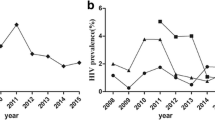Abstract
To evaluate HIV/STI prevalence among female sex workers (FSWs) in Botswana, and assess HIV-related risk behaviors. Cross-sectional study using time-location sampling in three districts of Botswana. Adjusted HIV prevalence at district level ranged from 53.5 to 68.5 %. Syphilis prevalence ranged from 3.7 to 14.5 %; chlamydia prevalence ranged from 4.8 to 16.3 %; and gonorrhoea prevalence ranged from 8.3 to 11.7 %. FSWs had been practicing sex work for a mean of 4.7 years, and had a mean of 7.6 sex partners in the week before the survey. While 67.1 % of FSWs surveyed reported always using condoms with clients in the past month. 59.5 % reported one or more of the following: being paid more not to use a condom, having a condom break, or being forced not to use a condom by clients. Predictors of HIV infection in the multivariate analysis included: age (over 30 years), perceiving oneself to be at high risk of HIV, selling sex for 2 or more years, and having a mean of 11 or more partners in the last week. High HIV prevalence, high rates of partner exchange, a sizable population, and Inconsistent condom use combine together help fuel the country’s hyper epidemic. HIV prevention interventions need to take into account the important influence of clients and boyfriends on condom use behavior.

Similar content being viewed by others
References
Central Statistics Office. 2011 population and housing census preliminary results brief. Gaborone: Government of Botswana; 2012.
Statistics Botswana. BAIS IV Final Results Presentation. Stats Brief: Preliminary Results Botswana AIDS Impact Survey IV (BAIS IV), 2013. Government of Botswana, Gaborone, 2014.
UNAIDS Inter-Agency Task Team on Gender and HIV/AIDS. HIV/AIDS, gender and sex work. Available at: http://www.unfpa.org/hiv/docs/factsheet_genderwork.pdf. Accessed: 20 November, 2013.
Pruss-Ustun A, Wolf J, Driscoll T, Degenhardt L, Neira M, Calleja J. HIV due to female sex work: regional and global estimates. PLoS One. 2013;8(5):e63476. doi:10.1371/journal.pone.0063476.
UNAIDS. UNAIDS report on the global AIDS epidemic 2012. JC2417E. Geneva, 2013.
Scorgie F, Chersich M, Ntaganira I, Gerbase A, Lule F, Lo Y. Socio-demographic characteristics and behavioral risk factors of female sex workers in sub-Saharan Africa: a systematic review. AIDS Behav. 2012;16:920–33.
Baral S, Beyrer C, Muessig K, Poteat T, Wirtz A, Decker M, et al. Burden of HIV among female sex workers in low-income and middle-income countries: a systematic review and meta-analysis. Lancet Infect Dis. 2012;12(7):538–49.
Shannon K, Montaner J. The politics and policies of HIV prevention in sex work. Lancet Infect Dis. 2012;12(7):500–2.
Scheibe A, Drame F, Shannon K. HIV prevention among female sex workers in Africa. J Soc Asp HIV/AIDS Res. 2012;9(3):167–72 Alliance/SAHARA, Human Sciences Research Council.
Mooney A, Kidanu A, Bradley H, Kumoji E, Kennedy C, Kerrigan D. Work-related violence and inconsistent condom use with non-paying partners among female sex workers in Adama City, Ethiopia. BMC Public Health. 2013;13:771.
National AIDS Coordinating Agency. The second Botswana national strategic framework for HIV and AIDS, 2010–2016. Gaborone: Government of Botswana; 2009.
Gaotlhobogwe P, Mosienyane K, Ramotlhwa S, Macharia D. Integrating STI screening and HIV prevention services for MARPs in Botswana. Paper presented at the 6th IAS Conference on HIV Pathogenesis, Treatment and Prevention, 17–20 July, 2011, in Rome, Italy [Abstract # CDD250].
Sharma A, O’Malley G. HIV needs assessment of female sex workers in major towns, mining towns, and along major roads in Botswana. Gaborone: I-Tech, University of Washington; 2007.
Raymond HF, Ick T, Grasso M, Vaudrey J, McFarland W. Resource guide: time location sampling (TLS). 2nd ed. San Francisco: San Francisco Department of Public Health; 2007.
World Health Organization/UNAIDS. Guidelines on estimating the size of population’s most at risk to HIV. Geneva: World Health Organization; 2010.
Chersich M, Luchters S, Ntaganira I, Gerbase A, Lo Y, Scorgie F, et al. Priority interventions to reduce HIV transmission in sex work settings in sub-Saharan Africa and delivery of these services. J Int AIDS Soc. 2013;16:17980.
Fazito E, Cuchi P, Mahy M, Brown T. Analysis of duration of risk behavior for key populations: a literature review. Sex Transm Infect. 2012;88:i24–32.
Wang C, Hawes S, Gaye A, Sow P, Ndoye I, Manhart L, et al. HIV prevalence, previous HIV testing, and condom use with clients and regular partners among Senegalese commercial sex workers. Sex Transm Infect. 2007;83(7):534–40.
Wariki W, Ota E, Mori R, Koyanagi A, Hori N, Shibuya K. Behavioral interventions to reduce the transmission of HIV infection among sex workers and their clients in low- and middle-income countries. Cochrane Database Syst Rev. 2012;2:005272. doi:10.1002/14651858.CD005272.pub3.
World Health Organisation (WHO). Sex work: key facts and figures. The sex work toolkit. Available at: http://www.who.int/3by5/en/factsheet.pdf. Accessed: November 12, 2013.
Acknowledgments
The study was funded by the Ministry of Health, Republic of Botswana, USAID and WHO. This work is made possible by the generous support of the American people through the U.S. Agency for International Development (USAID). Financial assistance was provided by USAID to FHI 360 under the terms of the Preventive Technologies Agreement No. GHO-A-00-09-00016-00. The contents do not necessarily reflect the views of USAID or the United States Government.
Conflict of interest
No conflicts of interests for any authors were declared.
Author information
Authors and Affiliations
Corresponding author
Rights and permissions
About this article
Cite this article
Merrigan, M.B., Tafuma, T.A., Okui, L.A. et al. HIV Prevalence and Risk Behaviors Among Female Sex Workers in Botswana: Results from the 2012 HIV/STI Bio-Behavioral Study. AIDS Behav 19, 899–908 (2015). https://doi.org/10.1007/s10461-014-0858-0
Published:
Issue Date:
DOI: https://doi.org/10.1007/s10461-014-0858-0




